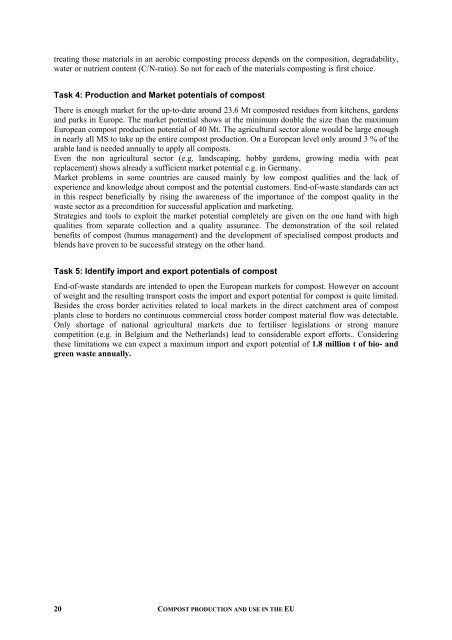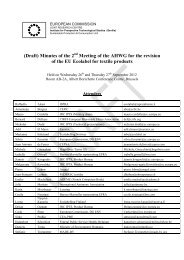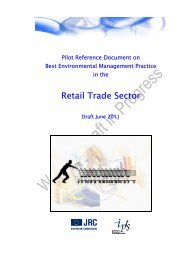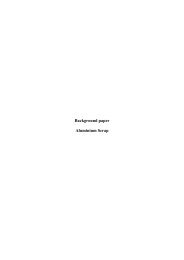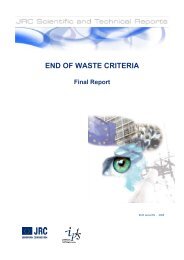final report - JRC IPTS - Sustainable Production and Consumption ...
final report - JRC IPTS - Sustainable Production and Consumption ...
final report - JRC IPTS - Sustainable Production and Consumption ...
You also want an ePaper? Increase the reach of your titles
YUMPU automatically turns print PDFs into web optimized ePapers that Google loves.
treating those materials in an aerobic composting process depends on the composition, degradability,<br />
water or nutrient content (C/N-ratio). So not for each of the materials composting is first choice.<br />
Task 4: <strong>Production</strong> <strong>and</strong> Market potentials of compost<br />
There is enough market for the up-to-date around 23.6 Mt composted residues from kitchens, gardens<br />
<strong>and</strong> parks in Europe. The market potential shows at the minimum double the size than the maximum<br />
European compost production potential of 40 Mt. The agricultural sector alone would be large enough<br />
in nearly all MS to take up the entire compost production. On a European level only around 3 % of the<br />
arable l<strong>and</strong> is needed annually to apply all composts.<br />
Even the non agricultural sector (e.g. l<strong>and</strong>scaping, hobby gardens, growing media with peat<br />
replacement) shows already a sufficient market potential e.g. in Germany.<br />
Market problems in some countries are caused mainly by low compost qualities <strong>and</strong> the lack of<br />
experience <strong>and</strong> knowledge about compost <strong>and</strong> the potential customers. End-of-waste st<strong>and</strong>ards can act<br />
in this respect beneficially by rising the awareness of the importance of the compost quality in the<br />
waste sector as a precondition for successful application <strong>and</strong> marketing.<br />
Strategies <strong>and</strong> tools to exploit the market potential completely are given on the one h<strong>and</strong> with high<br />
qualities from separate collection <strong>and</strong> a quality assurance. The demonstration of the soil related<br />
benefits of compost (humus management) <strong>and</strong> the development of specialised compost products <strong>and</strong><br />
blends have proven to be successful strategy on the other h<strong>and</strong>.<br />
Task 5: Identify import <strong>and</strong> export potentials of compost<br />
End-of-waste st<strong>and</strong>ards are intended to open the European markets for compost. However on account<br />
of weight <strong>and</strong> the resulting transport costs the import <strong>and</strong> export potential for compost is quite limited.<br />
Besides the cross border activities related to local markets in the direct catchment area of compost<br />
plants close to borders no continuous commercial cross border compost material flow was detectable.<br />
Only shortage of national agricultural markets due to fertiliser legislations or strong manure<br />
competition (e.g. in Belgium <strong>and</strong> the Netherl<strong>and</strong>s) lead to considerable export efforts.. Considering<br />
these limitations we can expect a maximum import <strong>and</strong> export potential of 1.8 million t of bio- <strong>and</strong><br />
green waste annually.<br />
20<br />
COMPOST PRODUCTION AND USE IN THE EU


